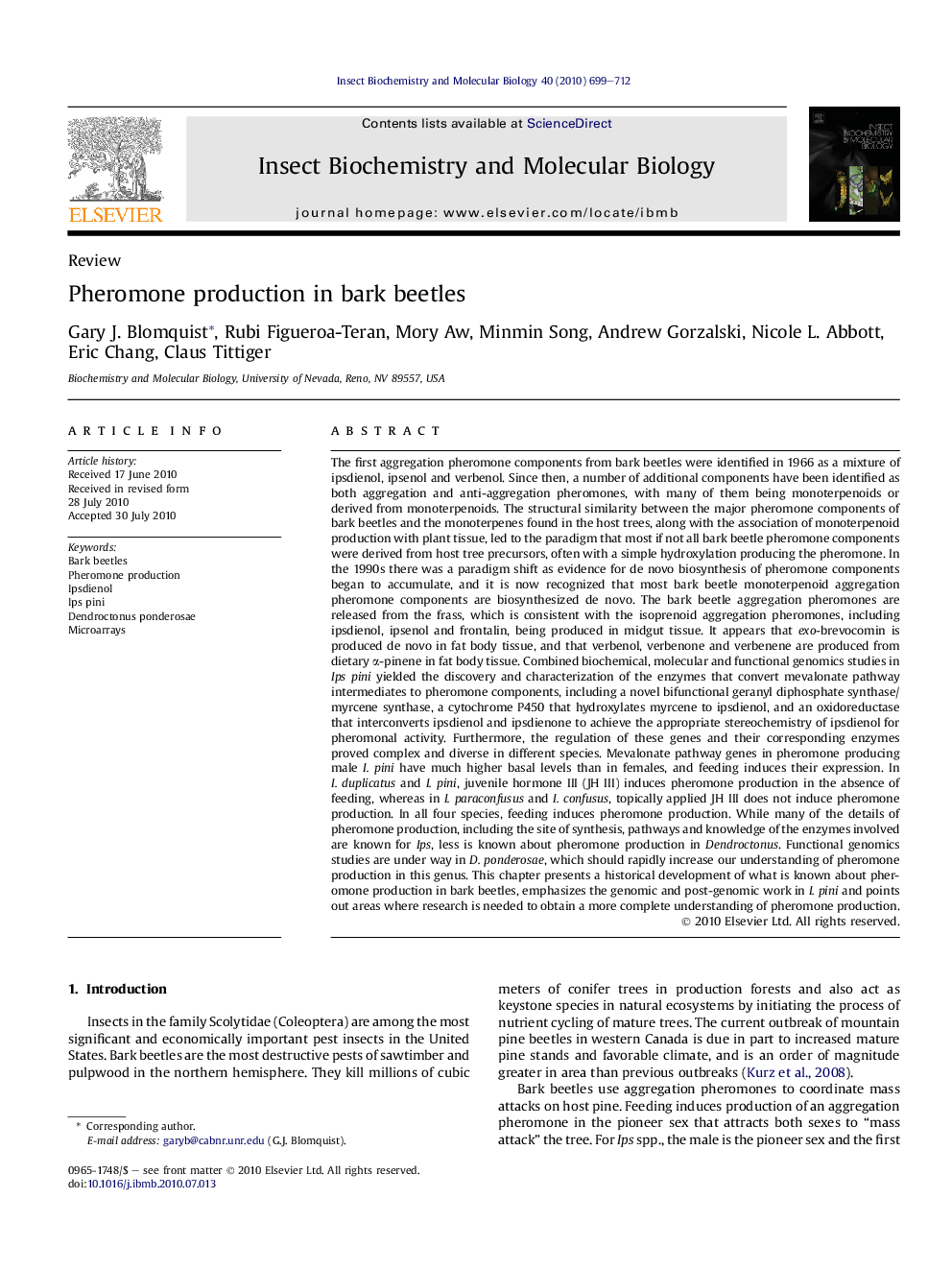| کد مقاله | کد نشریه | سال انتشار | مقاله انگلیسی | نسخه تمام متن |
|---|---|---|---|---|
| 1982556 | 1062298 | 2010 | 14 صفحه PDF | دانلود رایگان |

The first aggregation pheromone components from bark beetles were identified in 1966 as a mixture of ipsdienol, ipsenol and verbenol. Since then, a number of additional components have been identified as both aggregation and anti-aggregation pheromones, with many of them being monoterpenoids or derived from monoterpenoids. The structural similarity between the major pheromone components of bark beetles and the monoterpenes found in the host trees, along with the association of monoterpenoid production with plant tissue, led to the paradigm that most if not all bark beetle pheromone components were derived from host tree precursors, often with a simple hydroxylation producing the pheromone. In the 1990s there was a paradigm shift as evidence for de novo biosynthesis of pheromone components began to accumulate, and it is now recognized that most bark beetle monoterpenoid aggregation pheromone components are biosynthesized de novo. The bark beetle aggregation pheromones are released from the frass, which is consistent with the isoprenoid aggregation pheromones, including ipsdienol, ipsenol and frontalin, being produced in midgut tissue. It appears that exo-brevocomin is produced de novo in fat body tissue, and that verbenol, verbenone and verbenene are produced from dietary α-pinene in fat body tissue. Combined biochemical, molecular and functional genomics studies in Ips pini yielded the discovery and characterization of the enzymes that convert mevalonate pathway intermediates to pheromone components, including a novel bifunctional geranyl diphosphate synthase/myrcene synthase, a cytochrome P450 that hydroxylates myrcene to ipsdienol, and an oxidoreductase that interconverts ipsdienol and ipsdienone to achieve the appropriate stereochemistry of ipsdienol for pheromonal activity. Furthermore, the regulation of these genes and their corresponding enzymes proved complex and diverse in different species. Mevalonate pathway genes in pheromone producing male I. pini have much higher basal levels than in females, and feeding induces their expression. In I. duplicatus and I. pini, juvenile hormone III (JH III) induces pheromone production in the absence of feeding, whereas in I. paraconfusus and I. confusus, topically applied JH III does not induce pheromone production. In all four species, feeding induces pheromone production. While many of the details of pheromone production, including the site of synthesis, pathways and knowledge of the enzymes involved are known for Ips, less is known about pheromone production in Dendroctonus. Functional genomics studies are under way in D. ponderosae, which should rapidly increase our understanding of pheromone production in this genus. This chapter presents a historical development of what is known about pheromone production in bark beetles, emphasizes the genomic and post-genomic work in I. pini and points out areas where research is needed to obtain a more complete understanding of pheromone production.
Figure optionsDownload high-quality image (93 K)Download as PowerPoint slideResearch highlights
► Reviews the historical development of our understanding of pheromone production in bark beetles. Discusses the paradigm shift that led to our understanding the most components are made de novo. Discusses the EST/microarray data that led to the discovery of the genes/enzymes involved in ipsdienol production. Presents a snapshot of the current work on EST/microarray data on Dendroctonus ponderosae pheromone production. Discusses the evolution of pheromone production in bark beetles.
Journal: Insect Biochemistry and Molecular Biology - Volume 40, Issue 10, October 2010, Pages 699–712